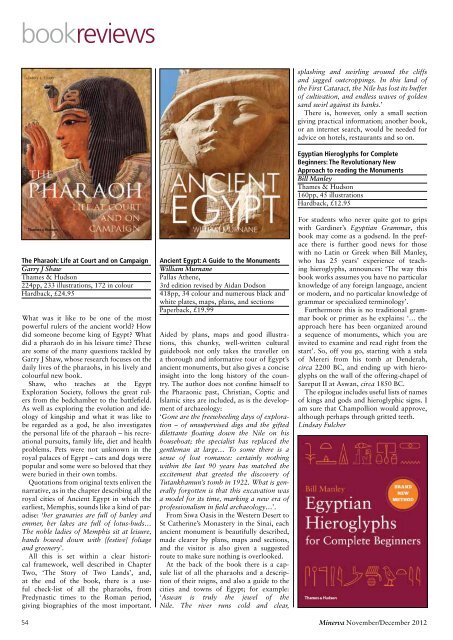Following Odysseus Not the end of the world Amarna city of light ...
Following Odysseus Not the end of the world Amarna city of light ...
Following Odysseus Not the end of the world Amarna city of light ...
- No tags were found...
Create successful ePaper yourself
Turn your PDF publications into a flip-book with our unique Google optimized e-Paper software.
ookreviewsThe Pharaoh: Life at Court and on CampaignGarry J ShawThames & Hudson224pp, 233 illustrations, 172 in colourHardback, £24.95What was it like to be one <strong>of</strong> <strong>the</strong> mostpowerful rulers <strong>of</strong> <strong>the</strong> ancient <strong>world</strong>? Howdid someone become king <strong>of</strong> Egypt? Whatdid a pharaoh do in his leisure time? Theseare some <strong>of</strong> <strong>the</strong> many questions tackled byGarry J Shaw, whose research focuses on <strong>the</strong>daily lives <strong>of</strong> <strong>the</strong> pharaohs, in his lively andcolourful new book.Shaw, who teaches at <strong>the</strong> EgyptExploration Society, follows <strong>the</strong> great rulersfrom <strong>the</strong> bedchamber to <strong>the</strong> battlefield.As well as exploring <strong>the</strong> evolution and ideology<strong>of</strong> kingship and what it was like tobe regarded as a god, he also investigates<strong>the</strong> personal life <strong>of</strong> <strong>the</strong> pharaoh – his recreationalpursuits, family life, diet and healthproblems. Pets were not unknown in <strong>the</strong>royal palaces <strong>of</strong> Egypt – cats and dogs werepopular and some were so beloved that <strong>the</strong>ywere buried in <strong>the</strong>ir own tombs.Quotations from original texts enliven <strong>the</strong>narrative, as in <strong>the</strong> chapter describing all <strong>the</strong>royal cities <strong>of</strong> Ancient Egypt in which <strong>the</strong>earliest, Memphis, sounds like a kind <strong>of</strong> paradise:‘her granaries are full <strong>of</strong> barley andemmer, her lakes are full <strong>of</strong> lotus-buds…The noble ladies <strong>of</strong> Memphis sit at leisure,hands bowed down with [festive] foliageand greenery’.All this is set within a clear historicalframework, well described in ChapterTwo, ‘The Story <strong>of</strong> Two Lands’, and,at <strong>the</strong> <strong>end</strong> <strong>of</strong> <strong>the</strong> book, <strong>the</strong>re is a usefulcheck-list <strong>of</strong> all <strong>the</strong> pharaohs, fromPredynastic times to <strong>the</strong> Roman period,giving biographies <strong>of</strong> <strong>the</strong> most important.54Ancient Egypt: A Guide to <strong>the</strong> MonumentsWilliam MurnanePallas A<strong>the</strong>ne,3rd edition revised by Aidan Dodson418pp, 34 colour and numerous black andwhite plates, maps, plans, and sectionsPaperback, £19.99Aided by plans, maps and good illustrations,this chunky, well-written culturalguidebook not only takes <strong>the</strong> traveller ona thorough and informative tour <strong>of</strong> Egypt’sancient monuments, but also gives a conciseinsight into <strong>the</strong> long history <strong>of</strong> <strong>the</strong> country.The author does not confine himself to<strong>the</strong> Pharaonic past, Christian, Coptic andIslamic sites are included, as is <strong>the</strong> development<strong>of</strong> archaeology:‘Gone are <strong>the</strong> freewheeling days <strong>of</strong> exploration– <strong>of</strong> unsupervised digs and <strong>the</strong> gifteddilettante floating down <strong>the</strong> Nile on hishouseboat; <strong>the</strong> specialist has replaced <strong>the</strong>gentleman at large… To some <strong>the</strong>re is asense <strong>of</strong> lost romance: certainly nothingwithin <strong>the</strong> last 90 years has matched <strong>the</strong>excitement that greeted <strong>the</strong> discovery <strong>of</strong>Tutankhamun’s tomb in 1922. What is generallyforgotten is that this excavation wasa model for its time, marking a new era <strong>of</strong>pr<strong>of</strong>essionalism in field archaeology…’.From Siwa Oasis in <strong>the</strong> Western Desert toSt Ca<strong>the</strong>rine’s Monastery in <strong>the</strong> Sinai, eachancient monument is beautifully described,made clearer by plans, maps and sections,and <strong>the</strong> visitor is also given a suggestedroute to make sure nothing is overlooked.At <strong>the</strong> back <strong>of</strong> <strong>the</strong> book <strong>the</strong>re is a capsulelist <strong>of</strong> all <strong>the</strong> pharaohs and a description<strong>of</strong> <strong>the</strong>ir reigns, and also a guide to <strong>the</strong>cities and towns <strong>of</strong> Egypt; for example:‘Aswan is truly <strong>the</strong> jewel <strong>of</strong> <strong>the</strong>Nile. The river runs cold and clear,splashing and swirling around <strong>the</strong> cliffsand jagged outcroppings. In this land <strong>of</strong><strong>the</strong> First Cataract, <strong>the</strong> Nile has lost its buffer<strong>of</strong> cultivation, and <strong>end</strong>less waves <strong>of</strong> goldensand swirl against its banks.’There is, however, only a small sectiongiving practical information; ano<strong>the</strong>r book,or an internet search, would be needed foradvice on hotels, restaurants and so on.Egyptian Hieroglyphs for CompleteBeginners: The Revolutionary NewApproach to reading <strong>the</strong> MonumentsBill ManleyThames & Hudson160pp, 45 illustrationsHardback, £12.95For students who never quite got to gripswith Gardiner’s Egyptian Grammar, thisbook may come as a gods<strong>end</strong>. In <strong>the</strong> preface<strong>the</strong>re is fur<strong>the</strong>r good news for thosewith no Latin or Greek when Bill Manley,who has 25 years’ experience <strong>of</strong> teachinghieroglyphs, announces: ‘The way thisbook works assumes you have no particularknowledge <strong>of</strong> any foreign language, ancientor modern, and no particular knowledge <strong>of</strong>grammar or specialized terminology’.Fur<strong>the</strong>rmore this is no traditional grammarbook or primer as he explains: ‘… <strong>the</strong>approach here has been organized arounda sequence <strong>of</strong> monuments, which you areinvited to examine and read right from <strong>the</strong>start’. So, <strong>of</strong>f you go, starting with a stela<strong>of</strong> Mereri from his tomb at D<strong>end</strong>erah,circa 2200 BC, and <strong>end</strong>ing up with hieroglyphson <strong>the</strong> wall <strong>of</strong> <strong>the</strong> <strong>of</strong>fering-chapel <strong>of</strong>Sareput II at Aswan, circa 1850 BC.The epilogue includes useful lists <strong>of</strong> names<strong>of</strong> kings and gods and hieroglyphic signs. Iam sure that Champollion would approve,although perhaps through gritted teeth.Lindsay FulcherMinerva November/December 2012
















